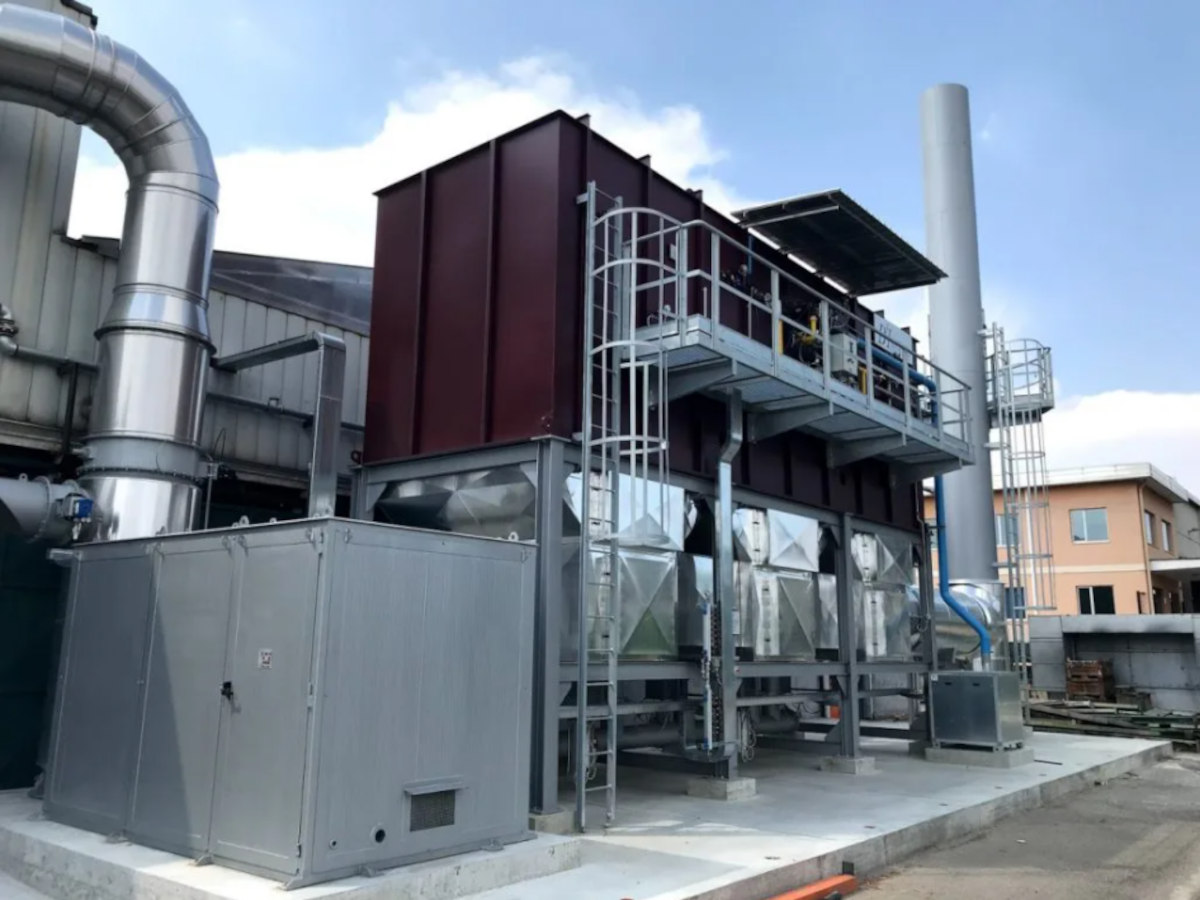Regenerative thermal oxidizers (RTO) are machines equipped with ceramic mass regenerative heat exchangers which allow for a high thermal efficiency thanks to their capability of quickly accumulating and yielding heat. This characteristic of theirs makes it possible to implement plants which yield up to 96%. The high heat recovery implemented by the correct sizing of the ceramic exchanger allow the plant to be self-sufficient, namely switching off the burner, which entails nullifying machine fuel consumption. The calorific value of the pollutant (VOC) present in the stream which burns in the combustion chamber therefore maintains the combustion temperature. Regenerative thermal oxidizers are configured based on their specific application and can be grouped as follows:
- Double chamber RTO, with optional compensation chamber;
- 3-5-7 chamber RTO, to be defined based on the flow rates of the process gas to be treated.
These machines are generally applied for all of those VOC laden emissions with 2-3 g/Nm3 or more to exploit self-sufficiency. Whereas for lower concentrations, they are the only system capable of minimising the operating cost of the machine due to the high heat recovery.
Features and advantages of rto system
- Electrical switchgear with PLC and remote assistance
- Independent combustion system to guarantee correct operation of the plant
- Modulating combustion system to maintain the correct operating temperature with the different incoming pollutant loads
- Combustion chamber refractory interior with high density ceramic fibre insulation allowing the plant to last longer
- Specific design to be applied with pollutant concentrations up to 25% of LEL
- High purification efficiency (98-99.5%)
- High thermal efficiency (92-96%)
- Reduced production of secondary pollutants (CO, NOx)
- Possibility of further heat recovery
- Reduced maintenance
Rto plant – Operating principle
The polluted air is extracted by a fan which is designed to overcome the pressure drops of the system. An exhaust adjustment system (inverter) is installed when there is a variable flow rate so as to optimise energy consumption. The plant generally consists of three towers containing ceramic material which cyclically accumulate and release heat, connected one to another at the top by a combustion chamber. The first tower which contains ceramic material is crossed by the cold air to be treated from the bottom upwards. It absorbs the heat accumulated by the ceramic during the previous cycle with the treated outgoing effluent. Purified hot air passes through the second tower, coming from the combustion chamber which it absorbs heat from. The third tower is purged and cleaned from pollutant residues to prepare it for the effluent outflow in the next cycle. Purging is useful since this chamber previously contained the incoming polluted effluent. A series of valves, specifically designed and tested for reliability and safety, alternate the inlet and outlet of the effluent into the reactors, thus achieving a cyclical process. This thermal exchange system, obtained by using ceramic masses, allows close to 96% heat recovery, making the plant self-sufficient meaning zero auxiliary fuel consumption with an incoming concentration generally close to 2 grams. The type of ceramic material used to accumulate heat is optimised to guarantee both reduced electric energy consumption and low auxiliary fuel consumption as well as minimise congestion due to the presence of particulate (organic or inorganic).
Plant engineering solutions
- Turnkey supply
- Dual chamber, dual chamber with compensation or multi-chamber (>3)
- Flameless operation
- Hot bypass
- Specific choice of materials based on the application (high inlet temperature, corrosive gases)
- Quenchers and scrubbers for halogenated pollutants
- Secondary heat recovery thanks to our energy recovery solutions
- NOx low emission burners
Thermal oxidizers with pre/post treatment
Plants designed by integrating pre-and post abatement sections to the main oxidizer are used when complex pollutant streams need to be treated with several different technologies.
The pre-treatments and therefore the pre-scrubbers are used to preserve the thermal oxidizer both from a mechanical and process point of view, reducing the concentration of particular types of pollutants such as:
organic silicone compounds
inorganic acids
inorganic bases
aerosol
dust
painting overspray
oily mist and/or condensate droplets
In this condition, appropriate systems are installed, such as cyclones, bag or cartridge filters, Venturi and tower scrubbers, filtering panels, activated carbon adsorbers, various types of demisters or even more complex systems to evaluate for each case.
For post-treatments and therefore for the post-scrubbers, rapid cooling systems are typically used such as quenchers followed by tower scrubbers possibly with Venturi-pre-abatement.
At times DeNOx SCR or SNCR systems could need to be used to reduce NOx consisting of particular organic compounds such as amines.
The various post-abatement systems are applied in the presence of incoming pollutants such as:
Halogenated VOC
Sulphurised VOC
Nitrogenous VOC
Silanes or siloxanes
Services provided
The Brofind regenerative thermal oxidizer was designed as part of a wide range of Brofind technologically advanced but easy-to-use atmospheric pollution control products. Since 1993, the company’s experience in VOC reduction includes the production of regenerative, recuperative, catalytic and direct combustion thermal oxidizers, sized from a few hundred to hundreds of thousands of Nm3 /h. All of the systems are designed for perfect integration in the process, optimal performance and trouble-free operation
Choosing Brofind means:
- Customer assistance 24/7
- Impartiality in recommending pollution control technologies since Brofind is owner of many of them
- Experience in the design and manufacturing of abatement plants since 1993
See the page dedicated to Brofind services to understand how we support our customers during the entire lifecycle of the product.






